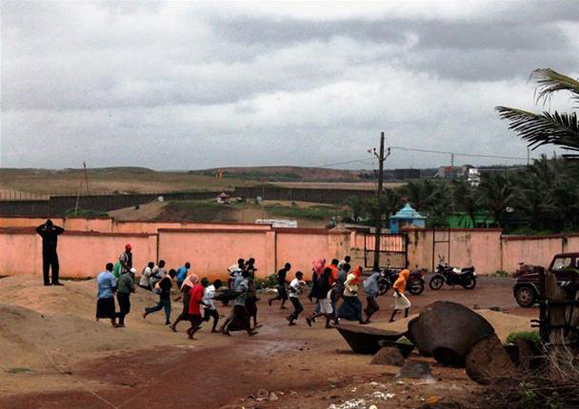
Bhubaneshwar, Oct 12: Bracing for Cyclone Phailin which is expected to hit the east coast on Saturday evening, the National Disaster Management Authority said it has deployed nearly 2,000 personnel of the National Disaster Response Force in Andhra Pradesh, Odisha and West Bengal.
Over 4.25 lakh people in Odisha and one lakh in Andhra Pradesh have been evacuated, said Home Secretary Anil Goswami in New Delhi. “This might be the second biggest evacuation exercise undertaken since 1990 when six lakh people were evacuated in Andhra Pradesh,” NDMA vice-chairman M. Shashidhar Reddy told reporters in New Delhi.
He said over 50 rescue teams with nearly 2,000 personnel have been put in place in Odisha, Andhra Pradesh and West Bengal.
Rescue and relief teams have been positioned in vulnerable coastal areas of the three States. Some additional teams have also been kept as reserve.
Twenty nine teams of the NDRF have been deployed with rescue equipment in Odisha. In Andhra Pradesh, 15 teams have been deployed and four additional teams are also being rushed from Tamil Nadu, while seven teams have been deployed in West Bengal.
The teams have been equipped with satellite phones and wireless sets to maintain smooth communication, in case normal communication lines are affected due to the cyclone.
Heavy rain pounds coastal Odisha
Heavy rainfall accompanied by wind continued to lash most part of coastal Odisha on Saturday as panic gripped millions of people along the coast about the landfall of cyclone Phailin near Gopalpur by evening.
“The cyclone is likely to hit the State near Gopalpur in Ganjam district by 6 p.m.,” said State Special Relief Commissioner P.K. Mohapat ra. “Phailin will have a maximum wind speed of 260 km,” Mr. Mohapatra added.
The cyclonic storm was about 200 km off Gopalpur coast by noon, according to officials.
The authorities had already evacuated 2.94 lakh people and efforts are on to evacuate more people from the low lying areas, Mr. Mohapatra said.
A large number of trees had been uprooted at several places, forcing the authorities to stop power supply in Bhubaneswar and Cuttack. Power failure in many areas had already affected normal life as people stayed indoors despite the Durga Puja festival.
The State government has set up many centres for packaging relief materials and the administration in all the districts likely to be hit by the cyclone was ready to cope with any eventuality.
The Meteorological Centre at Bhubaneswar has hoisted great danger signal number 10 for Gopalpur and Puri ports and great danger signal number 9 for Paradip and Chandbali ports.
Squally winds was likely to increase in intensity with gale wind speed reaching 100-150 km per hour from noon and 210-220 km per hour gusting to 240 km per hour along and off districts of Gajapati, Ganjam, Khurda, Puri, Jagatsinghpur, Cuttack, Bhadrak and Kendrapara of coastal Odisha at the time of landfall, the Meteorological Centre said.
Storm surge with a height of 3.0 to 3.5 metres above astronomical tide would inundate low lying areas of Ganjam, Khurda, Puri and Jagatsinghpur districts of Odisha during landfall, the Centre said.
Even after landfall, the system was likely to maintain the intensity of very severe cyclonic storm for six hours and gradually weaken into a cyclonic storm in subsequent six hours while moving northwestwards across interior Odisha. Under its influence rainfall at most places with heavy falls at a few places and extremely heavy falls at isolated places would occur over Odisha, the Centre said.
Navy, Coast Guard on standby in AP
In Andhra Pradesh, as many as 52,000 locals were on Saturday evacuated and 25,000 people accommodated in cyclone shelters in Srikakulam.
The East Godavari district administration has started shifting fishermen from Uppada-Kakinada area to safer places in view of the cyclone.
Irrigation officials are monitoring levels in water bodies in the coastal district, where medical teams have been kept ready.
Special control rooms have been set up in Kakinada, Ramachandrapuram and Amalapuram towns to monitor the situation.
Thirteen special officers have been deputed to assess the situation on the Andhra Pradesh coastline and 63 relief camps have been opened in the district.
Naval and Coast Guard services have been kept on standby in case of emergency.
Centre readies foodgrain supples
The Centre said 5 lakh tonnes of foodgrains is kept ready for distribution to victims of high intensity cyclone Phailin, which is due to hit the east coast in the next few hours.
“We are ready with 5 lakh tonnes of foodgrains for distribution to cyclone-affected people in Andhra Pradesh and Odisha,” Food Minister K.V. Thomas told reporters.
The foodgrains are available in government godowns in the respective states. “The centre and state governments are watching the situation. If more foodgrains are required, we will allocate,” he said.
In Odisha and Andhra Pradesh, people living on the coastline are being shifted to emergency locations before the cyclone stroms hits the region.
Cyclone ‘Phailin’ -- meaning sapphire in Thai language -- said to be one of the strongest cyclonic storms, is set to make a landfall this evening in Odisha’s Gopalpur





Comments
Add new comment